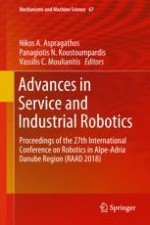This volume contains the proceedings of the RAAD 2018 conference, covering major areas of research and development in robotics. It provides an overview on the advances in robotics, more specifically in novel design and applications of robotic systems; dexterous grasping, handling and intelligent manipulation; intelligent cooperating and service robots; advanced robot control; human-robot interfaces; robot vision systems and visual serving techniques; mobile robots; humanoid and walking robots; field and agricultural robotics; bio-inspired and swarm robotic systems; developments towards micro and nano-scale robots; aerial, underwater and spatial robots; robot integration in holonic manufacturing; personal robots for ambient assisted living; medical robots and bionic prostheses; intelligent information technologies for cognitive robots etc.
The primary audience of the work are researchers as well as engineers in robotics and mechatronics.
